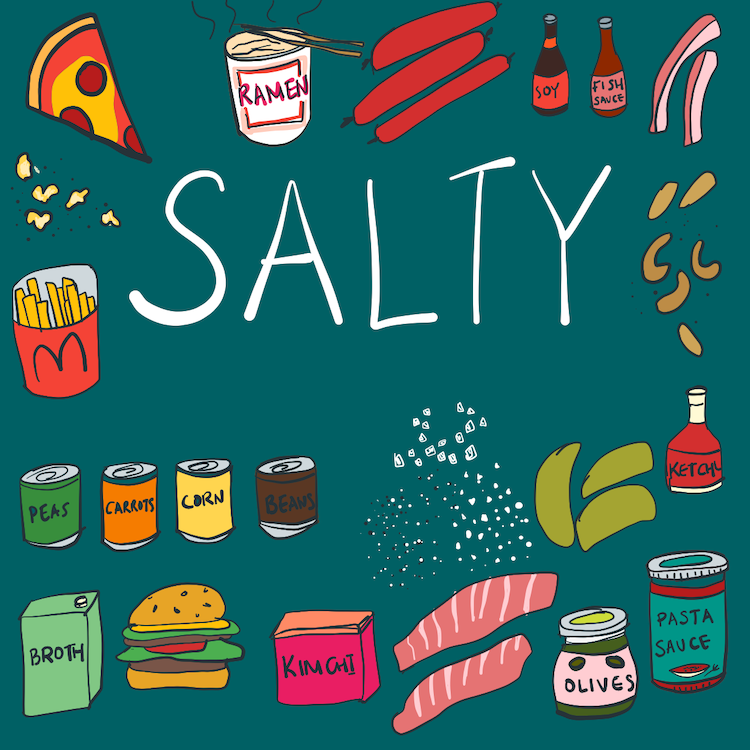The Magic Bullet To Making Your Food Instantly Taste Better
If you love eating, but don’t always love cooking, here’s a simple ingredient hiding right under your nose that can take your home-cooked meals to restaurant heights. Learn how to use it to make your food taste amazing instantly.
What is salty?
Saltiness is one of the basic tastes, along with sweetness, sourness, bitterness, and umami. We’re hardwired to detect saltiness in food because it signals the presence of important minerals. That’s why adding salt magically makes your food taste better.
Before you take it for granted that everybody knows you should add salt when cooking, the details are murky.
Restauranteurs tell us to add more salt than we think we should because most home cooking is under salted, and therefore bland. Yet, doctors are telling us to eat less salt. When I asked my friend Lindsay, whom I rely on for a dose of home cooking reality, she told me she heard that she should only add “salt when you’re done cooking” or the flavor goes away.
What’s the truth?
Let’s explore why salt is magical to understand how salt interacts with food and how you can use it to make your cooking taste better.
 GarlicDelight
GarlicDelight
Why do we add salt to food
Salt is a rock that’s made up of sodium and chloride ions (NaCl) (many salts exist in the world but table salt is predominantly NaCl). Salt is essential for humans. The sodium and chloride, along with trace minerals typically found in salt, such as potassium, iron, and calcium, are necessary for our nerve and muscles to function. Chloride helps balance our fluids and makes hydrochloric acid in our stomachs.
Our body craves salt because we need it to survive, according to Harvard School of Public Health. It makes sense that we have taste receptors that clock into salted food and makes us think this tastes good.
There’s plenty of research that suggests salt works as a flavor enhancer. Researchers, Paul Breslin and Gary Beauchamp, discovered that salt can suppress bitterness. Salt can “enhance sweetness, mask metallic or chemical off-notes, and round out overall flavors while improving flavor intensity”, according this book Strategies to Reduce Sodium Intake in the United States.
Another reason humans have added salt to food for thousands of years (and why food manufacturers do it today) is that salt is a great preservative. Bacteria can’t thrive in high concentrations of salt. This makes cured meats, fish, and preserved vegetables last a long time, especially without refrigeration.
Finally, we add salt to foods and during cooking for the chemical reactions. Salt is necessary for the Maillard reaction, caramelization, and browning, which make food taste complex and flavorful.
Salt is important when using yeast because it slows down yeast growth, which helps gluten formation and developing an even rise.
Salt is also helpful for brining and other chemical processes that tenderizes meat and locks in moisture.
Now that you understand the role of salt, let’s uncover how you can use it in your cooking.
Salts come in different sizes
You’ve probably noticed that there are at least a dozen different salts when you step into the spices aisle of your local grocery store.
Did you know that these salts not only have different colors and flavors but also different grain sizes, which will contribute to the level saltiness in your food?
Here’s a list of the most commonly found salts in most supermarkets (high-end food boutiques will likely include even more variety than what’s listed here) from the smallest to the largest grains.
- Popcorn salt
- Iodized salt
- Table salt
- Sea Salt
- Sel gris
- Kosher salt
- Smoked kosher salt
- Fleur de sel
- Haiwaiian salt
- Himalayan salt
- Onion salt
- Garlic salt
- Bagel salt
- Maldon salt
NOTE: Himalayan and Haiwaiian salt come in different grain sizes from finely ground to large crystals to solid blocks the size of copier paper. These salts are prized for their color and have been trendy in recent years.
The different grain sizes of salt make a big difference in how salty your food will taste if you salt by volume instead of by weight.
TIP: If tend to over salt your food, use a bigger grain size of salt, such as coarse kosher salt instead of fine-grained table salt. There are many fans of Diamond Crystal kosher salt, who love this brand because they claim the grain sizes are much bigger than Morton’s kosher salt, which make it easier to season without over salting.
